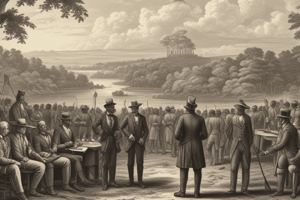Podcast
Questions and Answers
What critical political challenge was the Missouri Compromise primarily designed to address in 1820?
What critical political challenge was the Missouri Compromise primarily designed to address in 1820?
- Regulating immigration from Europe into the United States.
- Resolving disputes over taxation between the federal government and the states.
- Establishing federal control over interstate commerce.
- Maintaining the balance of power in Congress between free and slave states. (correct)
How did the admission of Maine as a free state directly relate to the admission of Missouri as a slave state under the Missouri Compromise?
How did the admission of Maine as a free state directly relate to the admission of Missouri as a slave state under the Missouri Compromise?
- Maine's admission was a prerequisite to ensure that the economic policies of the free states would not be undermined by the slave states.
- Maine's admission was unrelated, it was admitted as part of a separate legislative act focused on New England states.
- Maine's admission was conditional, and it was only allowed into the Union after Missouri demonstrated its economic viability as a slave state.
- Maine's admission was intended to offset the political influence of Missouri to maintain the balance between free and slave states in the Senate. (correct)
The Missouri Compromise prohibited slavery in the Louisiana Purchase territory north of the 36°30' line, except for Missouri. What immediate impact did this geographical limitation have on the expansion of slavery?
The Missouri Compromise prohibited slavery in the Louisiana Purchase territory north of the 36°30' line, except for Missouri. What immediate impact did this geographical limitation have on the expansion of slavery?
- It had no immediate impact; its effects were only seen after the Dred Scott decision.
- It encouraged slaveholders to migrate to territories south of the line, intensifying pro-slavery sentiments in those areas. (correct)
- It led to the immediate decline of cotton production in the southern states due to labor shortages.
- It effectively eliminated slavery in Arkansas, which was then considered part of the Louisiana Purchase.
Though intended to resolve tensions, the Missouri Compromise ultimately failed. Which later event demonstrated this failure by directly contradicting the terms set forth in the Compromise?
Though intended to resolve tensions, the Missouri Compromise ultimately failed. Which later event demonstrated this failure by directly contradicting the terms set forth in the Compromise?
How did the Dred Scott decision of 1857 undermine the Missouri Compromise and intensify sectional tensions in the United States?
How did the Dred Scott decision of 1857 undermine the Missouri Compromise and intensify sectional tensions in the United States?
Flashcards
Missouri Compromise
Missouri Compromise
Agreement in 1820 to balance free and slave states.
Key admission of states
Key admission of states
Missouri entered as a slave state, Maine as a free state.
36°30' Line
36°30' Line
Prohibited slavery north of this line in the Louisiana Purchase, except in Missouri.
Political Impact
Political Impact
Signup and view all the flashcards
Long-Term Effects
Long-Term Effects
Signup and view all the flashcards
Study Notes
- The Missouri Compromise was an agreement in 1820 that addressed slavery in new territories, and aimed to maintain the balance of power in the US between free and slave states.
- In 1819, the US consisted of 22 states, equally split between free and slave states.
- When Missouri, which was part of the Louisiana Purchase, requested statehood as a slave state, it risked upsetting the existing balance.
Key Provisions
- Missouri was admitted into the Union as a slave state.
- Maine, formerly part of Massachusetts, was admitted as a free state to preserve the balance.
- The 36°30' Line prohibited slavery in the Louisiana Purchase territory north of the 36°30' latitude, except for Missouri.
Political Impact
- Congressional tensions between pro-slavery and anti-slavery factions were temporarily eased.
- The balance between free and slave states was maintained at 12 each.
- The growing sectional divide over slavery was highlighted, especially with westward expansion.
Long-Term Effects
- The national conflict over slavery was only postponed, and tensions would continue to escalate.
- It established a precedent for future debates about slavery in new states and territories.
- In 1857, the Dred Scott decision declared the Missouri Compromise unconstitutional, further intensifying sectional tensions.
Significance
- This was an early attempt to address the divisive issue of slavery and preserve the Union; the tensions it sought to resolve eventually contributed to the Civil War.
Studying That Suits You
Use AI to generate personalized quizzes and flashcards to suit your learning preferences.




